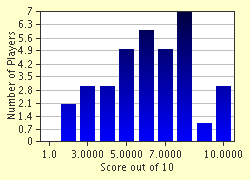Quiz Answer Key and Fun Facts
1. Instruments such as the piano, the guitar, and the harp are nice because they are "self-accompanying." Works for unaccompanied monophonic instruments -- instruments that typically play one note at a time -- are less common. Having said that, which of these pieces IS for solo piano?
2. Duos can be great fun for those who play them. Often, like instruments are paired (duos for two clarinets or two violins, for example), but English composer Malcolm Arnold wrote a duo in 1946 for flute and what alto-range string instrument?
3. Who composed a trio with the nickname of "Kegelstatt" in 1786? (Hint: the composer's middle name is Amadeus.)
4. The performance of Baroque era trio sonatas requires four people, not the expected three. What is the reason for this?
5. No wind instruments in this question: Franz Schubert's 1819 "Trout" quintet is scored for piano and four strings. Are these four strings a standard quartet of two violins, viola, and cello?
6. Francis Poulenc (1899-1963) added a piano to a woodwind quintet to produce a masterful sextet, but which of these instruments does NOT belong in a standard woodwind quintet?
7. Who in 1800 completed a six-movement masterpiece, his op. 20, uniting three winds with four strings in a colorful septet? (Hint: he eventually lost his hearing.)
8. French-American composer Edgard Varèse is recognized for having made major contributions to the development of "electronic art music." Did he include electronic effects of any kind in his 1923 composition, "Octandre"?
9. Among Bohuslav Martinu's many works is a lovely nonet for winds and strings. But when was Martinu active as a composer?
10. This gentleman's ballets -- "The Firebird," "The Rite of Spring," and "Petrushka," to name three -- are familiar to many listeners, but he also wrote numerous chamber works. Who was this composer of "Ragtime" for 11 instruments?
Source: Author
celicadriver
This quiz was reviewed by FunTrivia editor
ertrum before going online.
Any errors found in FunTrivia content are routinely corrected through our feedback system.

